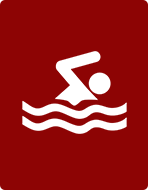
Toronto has some of the best beaches in the world, which is verified by the internationally recognized Blue Flag Program.
From June to September (Labour Day), the City of Toronto’s Parks, Forestry & Recreation division collects daily water samples from supervised beaches across the city to be tested for Escherichia coli (E.coli) bacteria. When E.coli levels are unsafe, Toronto Public Health (TPH) posts warning signs against swimming.
Beaches may also be unsafe due to lightning and thunderstorms, excessive weed growth, floating debris, oil and cloudy (turbid) water. Swimming in these waters could cause infections of the ear, eye, nose, throat and skin. If ingested, beach water may cause upset stomach, vomiting and diarrhea.
For Lake Ontario’s Surface Water Temperature, view the National Oceanic and Atmospheric Administration (NOAA) forecast.
TPH monitors beach water quality daily in accordance with the Ontario Recreational Water Protocol.
Look for these signs at the beach to stay informed on when it is safe to swim:


E.coli bacteria and other harmful organisms found in animal and human waste can be present in beach water depending on environmental conditions. Toronto Public Health (TPH) measures E.coli levels to determine the beach water quality and the safety conditions for public swimming. Bacteria levels can rise for the following reasons:
Toronto’s beach water quality standard is 100 E.coli per 100 mL of water, which is the most rigorous standard in the world (Ontario and Federal beach water quality standard is 200 E.coli per 100 mL of water). Swimming in water with E.coli levels greater than the City’s standard exposes the bather to increased risk of infections, including ear, eye, nose, throat and skin infections. If beach water is ingested, it may cause upset stomach, vomiting or diarrhea.
Infants and young children, seniors, people with a weakened immune system, existing illness or a chronic health condition are most at risk of infections from contact with harmful bacteria in polluted water.
The following notices are issued for each beach based on beach water quality testing:

E.coli levels are greater than the Toronto’s beach water quality standard and may increase the risk of infection to bathers. To prevent illness, the Medical Officer of Health recommends bathers do not enter water until E.coli levels decrease.

E.coli levels are within the City’s beach water quality standard.

Occasionally TPH is not able to test the water quality due to circumstances such as adverse weather conditions.
Water quality at beaches with possible contamination sources such as rivers and creeks are more likely to be unsafe for swimmers. Timely reporting is essential to keep residents informed on beach water quality. However, conventional laboratory test methods require more than 18 hours before results are available.
To overcome this limitation, Environment Canada scientists, in partnership with Toronto Public Health (TPH), have developed a quicker method of estimating beach water quality. Predictive Modeling uses the mathematical link between physical conditions (such as rainfall levels, wind direction and murkiness of water) to the levels of microbial contamination in beach water.
In 2022, TPH piloted Predictive Modeling in conjunction with conventional laboratory water testing methods to estimate beach water quality at Marie Curtis Park East, Sunnyside. The predictive modeling pilot project has now ended and is being evaluated. In 2023, TPH will continue to us conventional laboratory water testing methods to estimate beach water quality at all beaches. At this time the predictive model has been suspended for further assessment. As of 2025, predictive modeling has been suspended.

Blue Flag is an internationally recognized eco-label awarded to beaches that achieve high standards in 33 criteria across four categories: water quality, environmental education and information, environmental management, safety and services.
In addition to meeting these requirements, a Blue Flag beach must be accessible for an unannounced inspection by the Foundation for Environment Education (FEE).
Blue Flag awards are only valid for one season. If conditions at a Blue Flag beach change during the season or it fails to fulfill the imperative criteria then the Blue Flag award is withdrawn. After each season, all Blue Flag beaches must reapply and satisfy all of the requirements before an award is renewed.
The City of Toronto is working to improve beach water quality and our waterfront parks. You can help by not feeding local birds including ducks, geese, seagulls or swans.
Here is why:
Please dispose of food scraps in waste containers.